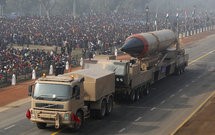 Several recent writings, including in the context of a possible revision of the Indian nuclear doctrine as mentioned in the BJP manifesto, have mentioned the need for a reconsideration of the no first use (NFU) principle. Many argue that India’s ‘retaliation only’ strategy may no longer be an effective deterrent in the wake of the recent developments in nuclear capabilities of its adversaries. The allegations against the NFU are that it is a pacifist, idealist, Gandhian strategy that has no role to play in the modern context.
Several recent writings, including in the context of a possible revision of the Indian nuclear doctrine as mentioned in the BJP manifesto, have mentioned the need for a reconsideration of the no first use (NFU) principle. Many argue that India’s ‘retaliation only’ strategy may no longer be an effective deterrent in the wake of the recent developments in nuclear capabilities of its adversaries. The allegations against the NFU are that it is a pacifist, idealist, Gandhian strategy that has no role to play in the modern context.
Is this really true? Is a first use nuclear doctrine more credible and better at deterrence than NFU? Would the adoption of first use doctrine by India deter Pakistan more and better?
Militaries like to function according to standard operating procedures (SOPs) – whether in peace or war. This inclines them towards offensive doctrines where they can stay with a pre-deliberated course of action while denying the adversary the advantage of playing out his moves. With conventional weapons, this may be a prudent approach, since the military can concentrate on the first phase of offense, thereby increasing its chance of victory. But the equation gets skewed with the entry of nuclear weapons.
In a situation where both sides have secure second strike nuclear capabilities, a first use of nuclear weapons, even in the form of a splendid first strike, cannot rule out the possibility of nuclear retaliation. Hence, the calculation of the first user cannot be limited to the damage it causes, but must also factor in the damage it will suffer from the response. Therefore, despite an offensive nuclear strategy, neither can victory be assured, nor the extent of damage (owing to the very nature of the weapon) be considered acceptable. Is it then useful, or even credible, to threaten first use of nuclear weapons?
In fact, even though conventional wisdom has us believe that first use is more liberating than a counter-strike strategy, serious thought to the actual execution of first use reveals the complexities involved in doing so. After all, the purpose of first use should be to deter by communicating that such use would substantially improve the situation of the user, making him emerge from the crisis looking better after use. This can only happen if there is no riposte to his action because if there is, then he can hardly ‘look better’ after suffering nuclear damage. Therefore, the essential question that the first user has to ask and answer is whether in a state of mutual vulnerability, the initiator can ever be in a better position?
An NFU strategy, on the other hand, concedes the onus of escalation to the adversary and surprisingly, becomes more liberating. Firstly, the military is not straining the nuclear leash on hair trigger alert that can easily fall prey to misadventure. Neither is there a need to perfect the logistics of first use, which is not easy considering that it requires coordinating a nuclear attack with speed and surprise to hit the adversary’s forces before they can be launched or dispersed. Secondly, the political leadership is freed from the psychological pressure of having to decide when, at what stage of war, to use the weapon - a decision that is sure to weigh on him/her personally for the damage caused, opprobrium earned, and retaliation invited and suffered.
First use postures based on projection of nuclear war-fighting require large arsenals of first strike weapons (such as accurate missiles with multiple independently re-targetable vehicles), nuclear superiority to carry out counter-force attacks, elaborate and delegated command and control structures to handle trigger readiness and coordinate simultaneous nuclear attacks from dispersed forces. None of this is easy. It is, rather, dangerous; raising the possibility of an accidental nuclear war based on a miscalculation, and also lowering the threshold of nuclear war in a crisis situation.
If Pakistan is going down this route, it is raising dangers for itself too. The answer to this from India does not have to be adoption of first use, but to enhance the credibility of its NFU, through better communication of survivability measures that ensure retaliation. It will be the threat of punishment that far outweighs any advantages that Pakistan reaps from its first use that will stay its hand on the trigger.
Meanwhile, by continuing with a stabilising posture of NFU, India is only helping itself since such a strategy alleviates the adversary’s insecurity that may tempt him towards a pre-emptive strike. By taking the ‘use or lose’ pressure off the adversary, India is helping its own cause of preventing deterrence breakdown.
By letting the adversary make the difficult decision, while communicating punitive nuclear retaliation, India has wisely steered away from nuclear brinkmanship. And, by establishing the nuclear weapon as an instrument of punishment, it has encouraged the possibility of ‘no use’ instead of ‘sure use’ of the nuclear weapon.
By Special Arrangement with : Institute of Peace and Conflict Studies (http://www.ipcs.org)